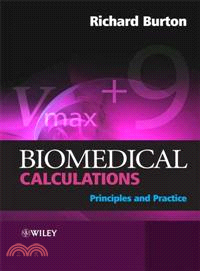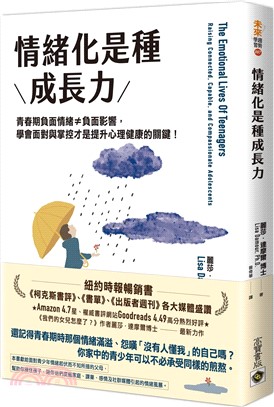Biomedical Calculations - Principles And Practice
商品資訊
相關商品
商品簡介
作者簡介
名人/編輯推薦
目次
商品簡介
"It is said if you take care of the pennies, the pounds will take care of themselves. Richard Burton's excellent book takes this approach to calculations applied to the biomedical sciences…This is certainly interesting and engaging but it avoids being complicated." –Journal of Biological Education, April 2009
Biomedical Calculations: Principles and Practice is an accessible, student-friendly introduction to calculating, applying formulae and solving quantitative problems within these subjects. This book targets a problem area for many students and aims to give them the confidence which they are so often lacking when undertaking scientific calculations. It takes a unique approach to the subject and uses unit analysis as a central theme throughout the book to enhance student understanding.
Clearly structured throughout, little basic knowledge of mathematics is assumed, but even the most numerate readers will be interested in the sometimes-novel biological detail. Numerous worked examples, supplementary questions and practice problems are provided and although the book is written to be read in sequence, it will also be a useful reference.
The central theme of the book focuses on the value of unit analysis in solving quantitative problems, with explanations on how to avoid errors in calculations and in checking, understanding and deriving formulae and equations. As a background to this, there is extensive treatment of physical units, both individually (e.g. kg, m, mmol) and in combination (e.g. m s¯², mmol L¯¹), and also of other aspects of quantitative thinking. A variety of topics (mostly from physiology, pharmacology and biochemistry) are used to demonstrate these calculations in practice.
Key features:
* An accessible, student-friendly introduction for all those hesitant in calculating, applying formulae and solving quantitative problems
* An innovative approach to scientific calculations and how to work with unfamiliar formulae for the biomedical and life sciences
* Includes modern, up to date definition of pH eliminating the need for logarithms and a discussion of the importance of pH
* Clear introduction on how to use the book, guidance on units and unit conversion, and an appendix on basic mathematics and notation
* Use of unit analysis as a central theme
* Includes numerous worked examples and supplementary questions throughout the text to enhance student understanding
* An innovative approach to scientific calculations and how to work with unfamiliar formulas for the biomedical and life sciences.
* Student friendly introduction to calculations, applying formulae and unit analysis.
* Includes modern, up to date definition of pH eliminating the need for logarithms, and a discussion of the importance of pH.
* Clearly structured with information on how to use the book and little prior knowledge of mathematics is assumed.
* Clear introduction on how to use the book and appendices on SI units, Unit conversion tables, mathematical notation, and dimensional analysis Use of unit analysis as a central theme
* Calculations and problems included throughout as practice exercises
* Includes numerous worked examples and supplementary questions throughout the text to enhance student understanding.
* Answers to problems included at the end of the book with clear explanations from the author.
* Emphasis on attention to units as the key to confident calculation
* Little mathematical knowledge is assumed beyond simple arithmetic
* The biological subject matter goes beyond what is to be found in other textbooks, even including the results of original research
Biomedical Calculations: Principles and Practice is an accessible, student-friendly introduction to calculating, applying formulae and solving quantitative problems within these subjects. This book targets a problem area for many students and aims to give them the confidence which they are so often lacking when undertaking scientific calculations. It takes a unique approach to the subject and uses unit analysis as a central theme throughout the book to enhance student understanding.
Clearly structured throughout, little basic knowledge of mathematics is assumed, but even the most numerate readers will be interested in the sometimes-novel biological detail. Numerous worked examples, supplementary questions and practice problems are provided and although the book is written to be read in sequence, it will also be a useful reference.
The central theme of the book focuses on the value of unit analysis in solving quantitative problems, with explanations on how to avoid errors in calculations and in checking, understanding and deriving formulae and equations. As a background to this, there is extensive treatment of physical units, both individually (e.g. kg, m, mmol) and in combination (e.g. m s¯², mmol L¯¹), and also of other aspects of quantitative thinking. A variety of topics (mostly from physiology, pharmacology and biochemistry) are used to demonstrate these calculations in practice.
Key features:
* An accessible, student-friendly introduction for all those hesitant in calculating, applying formulae and solving quantitative problems
* An innovative approach to scientific calculations and how to work with unfamiliar formulae for the biomedical and life sciences
* Includes modern, up to date definition of pH eliminating the need for logarithms and a discussion of the importance of pH
* Clear introduction on how to use the book, guidance on units and unit conversion, and an appendix on basic mathematics and notation
* Use of unit analysis as a central theme
* Includes numerous worked examples and supplementary questions throughout the text to enhance student understanding
* An innovative approach to scientific calculations and how to work with unfamiliar formulas for the biomedical and life sciences.
* Student friendly introduction to calculations, applying formulae and unit analysis.
* Includes modern, up to date definition of pH eliminating the need for logarithms, and a discussion of the importance of pH.
* Clearly structured with information on how to use the book and little prior knowledge of mathematics is assumed.
* Clear introduction on how to use the book and appendices on SI units, Unit conversion tables, mathematical notation, and dimensional analysis Use of unit analysis as a central theme
* Calculations and problems included throughout as practice exercises
* Includes numerous worked examples and supplementary questions throughout the text to enhance student understanding.
* Answers to problems included at the end of the book with clear explanations from the author.
* Emphasis on attention to units as the key to confident calculation
* Little mathematical knowledge is assumed beyond simple arithmetic
* The biological subject matter goes beyond what is to be found in other textbooks, even including the results of original research
作者簡介
Dr. Richard Francis Burton, Honorary Research Fellow, Thomson Building, Institute of Biomedical and Life Sciences, University of Glasgow, UK.
名人/編輯推薦
I really liked this book and the approach the author has taken. It will certainly be useful for biomedical scientists and for those teaching potential biomedical scientists, either at university or during training in the laboratory. ( British J of Biomedical Science, 2008)
"It is said if you take care of the pennies, the pounds will take care of themselves. Richard Burton's excellent book takes this approach to calculations applied to the biomedical sciences This is certainly interesting and engaging but it avoids being complicated." Journal of Biological Education, April 2009
"It is said if you take care of the pennies, the pounds will take care of themselves. Richard Burton's excellent book takes this approach to calculations applied to the biomedical sciences This is certainly interesting and engaging but it avoids being complicated." Journal of Biological Education, April 2009
目次
Preface.
Acknowledgements.
This book, and how to use it.
PART I.
1. Unit analysis: the neglected key to confidence.
1.1 Calculating with units.
1.2 Ways of writing composite units.
1.3 How unit analysis can guide thinking and help solve problems.
1.4 When to specify substances along with units.
1.5 The need to use appropriate and compatible units in formulae.
1.6 Checking and deriving formulae.
1.7 When unit analysis raises questions about formulae.
1.8 Dimensional analysis.
PART II.
2. Units: length, area, volume, mass, moles and equivalents.
2.1 The Système International and unit prefixes.
2.2 Length and distance.
2.3 Area.
2.4 Volume.
2.5 Mass.
2.6 Moles.
2.7 Equivalents.
2.8 Conversion between units.
Problems.
3. Percentages.
3.1 When percentages mislead: human body fat and fat in milk.
3.2 Heat loss from the body: further questionable percentages.
Problems.
4. Composite units I - density.
4.1 Specific gravity.
4.2 Specific volume.
4.3 Two definitions of body density.
4.4 Thinking about a formula.
Problems.
5. Composite units II - concentration.
5.1 Concentrations: kilograms of water vs litres of solution.
5.2 Simple protein-free salt solutions.
5.3 Millimolar and millimolal concentrations in blood plasma.
5.4 Some quite different uses for Eq. (5.1).
Problems.
6. Aspects of problem solving.
6.1 Letting unit analysis solve the problem.
6.2 ‘Let x be the unknown’.
Problems.
7. Making up and diluting solutions.
7.1 Preparing 250 mL of 150 mM NaCl from the dry salt.
7.2 Preparing dilutions from stock solutions.
Problems.
8. Calculating drug doses.
Problems.
9. More about solutions - electroneutrality, osmotic pressure and activity.
9.1 The principle of electroneutrality.
9.2 But what about membrane potentials and short-circuit currents?
9.3 Anion gap.
9.4 Osmoles and osmolality.
9.5 Osmolar gap.
9.6 Osmosity.
9.7 Cell contents.
9.8 Effective osmolality, effective osmotic pressure.
9.9 Osmotic shifts of water between cells and extracellular fluid.
9.10 Free and bound concentrations, activities.
PART III.
10. Graphs, straight lines and equations.
10.1 Graphs: some terminology.
10.2 Advice on drawing graphs.
10.3 The equation of a straight line.
10.4 Finding the equation of a line that passes through two specified points.
10.5 Drawing a line that is defined by a specified equation.
10.6 Finding the equation of a line from its gradient and the coordinates of a single point on it.
10.7 Finding the line that best fits a number of points when these lie only roughly in a straight line.
10.8 ‘Proportional’ and ‘inversely proportional’.
10.9 Gradients of curves.
10.10 A note on units.
10.11 On the different kinds of formulae and equations.
Problems.
11. On shapes and sizes.
11.1 Areas and volumes of simple shapes.
11.2 Erythrocytes, cylinders and spheres.
11.3 The swelling of erythrocytes in hypo-osmotic solutions.
11.4 Distortion of erythrocytes in passing along narrow blood vessels.
11.5 An exercise in rearranging equations to eliminate an unwanted term.
11.6 Easy and general ways to check algebraic working.
11.7 Solving the equation by trial and error in a spreadsheet.
11.8 Why do we not have naturally spherical erythrocytes?
11.9 General properties of simple geometrical shapes.
11.10 Replacing volumes with masses in these equations.
11.11 A digression on graphs.
11.12 Calculating surface area from volume and height: another exercise in re-arranging equations and eliminating unwanted terms.
11.13 Another digression to check algebraic working.
11.14 Generalizing the formula to include the human body.
11.15 Surface/volume and surface/mass ratios.
11.16 The surface area of the human body.
11.17 Standard formulae for body surface area.
11.18 An exercise in comparing formulae containing exponents.
Problems.
12. Body size, body build, fatness and muscularity: unit analysis as an aid to discovery.
12.1 Variations in fat-free mass with height and age.
12.2 The Rohrer index, or ‘height-weight index of build’.
12.3 The body mass index; estimating body fat from body mass and height.
12.4 Upper arm muscle: how its cross-sectional area varies with body height.
12.5 Weightlifting - and the cross-sectional area of muscle.
12.6 Estimating body fat from skinfold thickness measurements.
12.7 Postscript.
PART IV.
13. Introducing time.
13.1 Frequency.
13.2 Speed and velocity.
13.3 Acceleration.
13.4 Rates of flow of substances carried in fluids.
13.5 Thinking about a formula.
13.6 The concept of renal clearance.
13.7 Relating the clearance formula for renal plasma flow to the Fick Principle.
13.8 Creatinine clearance as a measure of GFR, and a convenient formula for estimating it.
Problems.
PART V.
14. Force, pressure, energy, work and power.
14.1 Force and weight.
14.2 Pressure.
14.3 Columns of water, columns of blood.
14.4 Osmotic pressure and colloid osmotic pressure (oncotic pressure).
14.5 Energy and work.
14.6 Power.
14.7 An overview of units - from mass to pressure and power.
Problems.
15. Lessons from another formula.
15.1 Poiseuille’s equation and viscosity.
15.2 Peripheral resistance.
Problems.
16. Heat and temperature.
16.1 Temperature scales.
16.2 The temperature coefficient, Q10.
16.3 Heat capacity and specific heat.
Problems.
17. Gases: dry and wet gas mixtures, partial pressures, gases in solution.
17.1 A reminder of units.
17.2 Natural variations in atmospheric pressure.
17.3 The gas laws.
17.4 A closer look at Eq. (17.1) and the universal gas constant, with attention to units.
17.5 Treatment of gas mixtures - percentages.
17.6 Treatment of gas mixtures - partial pressures, tensions.
17.7 Water vapour pressure.
17.8 ‘Standard temperature and pressure, dry’.
17.9 Dissolved O2 and CO2 in blood plasma and other fluids.
Problems.
PART VI.
18. Introduction to logarithms.
18.1 Definitions.
18.2 Rules for working with logarithms.
18.3 The usefulness of remembering log102.
18.4 Logarithmic scales on graphs.
18.5 What about units?
18.6 Natural logarithms.
Problems.
19. Exponential time courses.
19.1 Use of semi-logarithmic plots.
19.2 Common complications.
Problems.
20. Nernst equations in physiology and biochemistry: logarithms and ‘RT/zF’.
20.1 More on RT/zF.
Problems.
21. pH - two definitions and a possible dilemma for teachers.
21.1 pH as -log[H+].
21.2 The true definition of pH: pH as a number on a conventional scale.
21.3 The meaning of 10-pH.
21.4 Final comments.
Problems.
22. Equilibrium constants, the Henderson-Hasselbalch equation, dose-response curves.
22.1 Equilibrium constants.
22.2 Concentrations or activities?
22.3 The Henderson-Hasselbalch equation.
22.4 Application of the Henderson-Hasselbalch equation to drugs.
22.5 The dependence of [AB] on [A] when ([B] + [AB]) is constant.
22.6 Concentration-response curves, dose-response curves.
Problems.
23. Buffering and acid-base balance.
23.1 Non-bicarbonate buffering.
23.2 A link with dose-response curves.
23.3 Bicarbonate buffering.
23.4 CO2/HCO3- and non-bicarbonate buffers together.
23.5 The whole body: diet and the titratable acidity of urine.
23.6 Other aspects of acid-base balance.
Problems.
References.
Appendix A. Basic mathematics and mathematical language.
Appendix B. Some non-metric units.
Appendix C. Notes.
Appendix D. Solutions to problems.
Index.
Acknowledgements.
This book, and how to use it.
PART I.
1. Unit analysis: the neglected key to confidence.
1.1 Calculating with units.
1.2 Ways of writing composite units.
1.3 How unit analysis can guide thinking and help solve problems.
1.4 When to specify substances along with units.
1.5 The need to use appropriate and compatible units in formulae.
1.6 Checking and deriving formulae.
1.7 When unit analysis raises questions about formulae.
1.8 Dimensional analysis.
PART II.
2. Units: length, area, volume, mass, moles and equivalents.
2.1 The Système International and unit prefixes.
2.2 Length and distance.
2.3 Area.
2.4 Volume.
2.5 Mass.
2.6 Moles.
2.7 Equivalents.
2.8 Conversion between units.
Problems.
3. Percentages.
3.1 When percentages mislead: human body fat and fat in milk.
3.2 Heat loss from the body: further questionable percentages.
Problems.
4. Composite units I - density.
4.1 Specific gravity.
4.2 Specific volume.
4.3 Two definitions of body density.
4.4 Thinking about a formula.
Problems.
5. Composite units II - concentration.
5.1 Concentrations: kilograms of water vs litres of solution.
5.2 Simple protein-free salt solutions.
5.3 Millimolar and millimolal concentrations in blood plasma.
5.4 Some quite different uses for Eq. (5.1).
Problems.
6. Aspects of problem solving.
6.1 Letting unit analysis solve the problem.
6.2 ‘Let x be the unknown’.
Problems.
7. Making up and diluting solutions.
7.1 Preparing 250 mL of 150 mM NaCl from the dry salt.
7.2 Preparing dilutions from stock solutions.
Problems.
8. Calculating drug doses.
Problems.
9. More about solutions - electroneutrality, osmotic pressure and activity.
9.1 The principle of electroneutrality.
9.2 But what about membrane potentials and short-circuit currents?
9.3 Anion gap.
9.4 Osmoles and osmolality.
9.5 Osmolar gap.
9.6 Osmosity.
9.7 Cell contents.
9.8 Effective osmolality, effective osmotic pressure.
9.9 Osmotic shifts of water between cells and extracellular fluid.
9.10 Free and bound concentrations, activities.
PART III.
10. Graphs, straight lines and equations.
10.1 Graphs: some terminology.
10.2 Advice on drawing graphs.
10.3 The equation of a straight line.
10.4 Finding the equation of a line that passes through two specified points.
10.5 Drawing a line that is defined by a specified equation.
10.6 Finding the equation of a line from its gradient and the coordinates of a single point on it.
10.7 Finding the line that best fits a number of points when these lie only roughly in a straight line.
10.8 ‘Proportional’ and ‘inversely proportional’.
10.9 Gradients of curves.
10.10 A note on units.
10.11 On the different kinds of formulae and equations.
Problems.
11. On shapes and sizes.
11.1 Areas and volumes of simple shapes.
11.2 Erythrocytes, cylinders and spheres.
11.3 The swelling of erythrocytes in hypo-osmotic solutions.
11.4 Distortion of erythrocytes in passing along narrow blood vessels.
11.5 An exercise in rearranging equations to eliminate an unwanted term.
11.6 Easy and general ways to check algebraic working.
11.7 Solving the equation by trial and error in a spreadsheet.
11.8 Why do we not have naturally spherical erythrocytes?
11.9 General properties of simple geometrical shapes.
11.10 Replacing volumes with masses in these equations.
11.11 A digression on graphs.
11.12 Calculating surface area from volume and height: another exercise in re-arranging equations and eliminating unwanted terms.
11.13 Another digression to check algebraic working.
11.14 Generalizing the formula to include the human body.
11.15 Surface/volume and surface/mass ratios.
11.16 The surface area of the human body.
11.17 Standard formulae for body surface area.
11.18 An exercise in comparing formulae containing exponents.
Problems.
12. Body size, body build, fatness and muscularity: unit analysis as an aid to discovery.
12.1 Variations in fat-free mass with height and age.
12.2 The Rohrer index, or ‘height-weight index of build’.
12.3 The body mass index; estimating body fat from body mass and height.
12.4 Upper arm muscle: how its cross-sectional area varies with body height.
12.5 Weightlifting - and the cross-sectional area of muscle.
12.6 Estimating body fat from skinfold thickness measurements.
12.7 Postscript.
PART IV.
13. Introducing time.
13.1 Frequency.
13.2 Speed and velocity.
13.3 Acceleration.
13.4 Rates of flow of substances carried in fluids.
13.5 Thinking about a formula.
13.6 The concept of renal clearance.
13.7 Relating the clearance formula for renal plasma flow to the Fick Principle.
13.8 Creatinine clearance as a measure of GFR, and a convenient formula for estimating it.
Problems.
PART V.
14. Force, pressure, energy, work and power.
14.1 Force and weight.
14.2 Pressure.
14.3 Columns of water, columns of blood.
14.4 Osmotic pressure and colloid osmotic pressure (oncotic pressure).
14.5 Energy and work.
14.6 Power.
14.7 An overview of units - from mass to pressure and power.
Problems.
15. Lessons from another formula.
15.1 Poiseuille’s equation and viscosity.
15.2 Peripheral resistance.
Problems.
16. Heat and temperature.
16.1 Temperature scales.
16.2 The temperature coefficient, Q10.
16.3 Heat capacity and specific heat.
Problems.
17. Gases: dry and wet gas mixtures, partial pressures, gases in solution.
17.1 A reminder of units.
17.2 Natural variations in atmospheric pressure.
17.3 The gas laws.
17.4 A closer look at Eq. (17.1) and the universal gas constant, with attention to units.
17.5 Treatment of gas mixtures - percentages.
17.6 Treatment of gas mixtures - partial pressures, tensions.
17.7 Water vapour pressure.
17.8 ‘Standard temperature and pressure, dry’.
17.9 Dissolved O2 and CO2 in blood plasma and other fluids.
Problems.
PART VI.
18. Introduction to logarithms.
18.1 Definitions.
18.2 Rules for working with logarithms.
18.3 The usefulness of remembering log102.
18.4 Logarithmic scales on graphs.
18.5 What about units?
18.6 Natural logarithms.
Problems.
19. Exponential time courses.
19.1 Use of semi-logarithmic plots.
19.2 Common complications.
Problems.
20. Nernst equations in physiology and biochemistry: logarithms and ‘RT/zF’.
20.1 More on RT/zF.
Problems.
21. pH - two definitions and a possible dilemma for teachers.
21.1 pH as -log[H+].
21.2 The true definition of pH: pH as a number on a conventional scale.
21.3 The meaning of 10-pH.
21.4 Final comments.
Problems.
22. Equilibrium constants, the Henderson-Hasselbalch equation, dose-response curves.
22.1 Equilibrium constants.
22.2 Concentrations or activities?
22.3 The Henderson-Hasselbalch equation.
22.4 Application of the Henderson-Hasselbalch equation to drugs.
22.5 The dependence of [AB] on [A] when ([B] + [AB]) is constant.
22.6 Concentration-response curves, dose-response curves.
Problems.
23. Buffering and acid-base balance.
23.1 Non-bicarbonate buffering.
23.2 A link with dose-response curves.
23.3 Bicarbonate buffering.
23.4 CO2/HCO3- and non-bicarbonate buffers together.
23.5 The whole body: diet and the titratable acidity of urine.
23.6 Other aspects of acid-base balance.
Problems.
References.
Appendix A. Basic mathematics and mathematical language.
Appendix B. Some non-metric units.
Appendix C. Notes.
Appendix D. Solutions to problems.
Index.
主題書展
更多
主題書展
更多書展本週66折
您曾經瀏覽過的商品
購物須知
外文書商品之書封,為出版社提供之樣本。實際出貨商品,以出版社所提供之現有版本為主。部份書籍,因出版社供應狀況特殊,匯率將依實際狀況做調整。
無庫存之商品,在您完成訂單程序之後,將以空運的方式為你下單調貨。為了縮短等待的時間,建議您將外文書與其他商品分開下單,以獲得最快的取貨速度,平均調貨時間為1~2個月。
為了保護您的權益,「三民網路書店」提供會員七日商品鑑賞期(收到商品為起始日)。
若要辦理退貨,請在商品鑑賞期內寄回,且商品必須是全新狀態與完整包裝(商品、附件、發票、隨貨贈品等)否則恕不接受退貨。
























